What's the idea?
Full Truck Alliance operates in the Full Truck Load (FTL) and Less Truck Load (LTL) markets, which are projected to grow at a compound annual growth rate (CAGR) of 5.9% and 6.9%, respectively, between 2024 and 2030. Weak digitalization of the Chinese market: Full Truck Alliance has an opportunity to scale the business by replacing offline players in the Chinese logistics market.
A good time to enter: heavy rains in China caused Full Truck Alliance's capitalization to drop 25% from summer peaks, but the weather had only a limited impact on the company's business. In Q2 2024, the number of active average monthly shippers rose to a record 2.7 million (+32.8% y/y). Revenue from the company's relatively new transactional business increased 63.3% to nearly ¥1 billion by the end of the reporting period. In March 2024, Full Truck Alliance adopted a share buyback program with an authorized amount equivalent to $3.55% of the company's market capitalisation.
About Company
Full Truck Alliance (YMM) is a technology company operating a digital platform of the same name that connects shippers and trucking companies across China. The company provides digital, standardized and intelligent logistics infrastructure across the entire value chain. Full Truck Alliance was founded in 2017 and is headquartered in Guizhou, China.
Why do we like Full Truck Alliance Co Ltd?
Reason 1. Growth of the company's target markets
Full Truck Alliance operates a digital platform that connects shippers and carriers across China. Through the platform, truck drivers can select a suitable transportation order and shippers can place such orders.
The company's business is built around two areas, each of which forms its own segment of the transportation market:
- FTL (Full Truck Load) — a method of transportation of cargo when it fully occupies one unit of transport. The main advantage of this method of transportation is the speed of delivery: there is no need to waste time loading other shippers' cargoes in different locations.
- LTL (Less truck load) — a method of cargo transportation when the cargo occupies a part of the available volume of a transport unit and is transported together with associated cargo. The main advantage of this method is cost-effectiveness: the customer does not have to pay for unoccupied space in the vehicle.
Mordor Intelligence estimates the China FTL market to reach $350.27 billion in 2024 and grow to $495.25 billion by 2030, implying a CAGR of around 5.94% during the period. China’s LTL market, according to Mordor Intelligence, is projected to reach $137.95 billion by 2030 against $92.55 billion in 2024, implying a CAGR of 6.88%.
According to Full Truck Alliance estimates, China's logistics market accounts for a significant share of the national economy, about 11% of GDP, and is valued at ¥7 trillion. Of this, about ¥1.5 trillion is accounted for by the express market, which makes up about 3% of all orders on the Full Truck Alliance platform. The rest of the orders, worth about ¥5.5 trillion, are from the FTL and LTL markets.
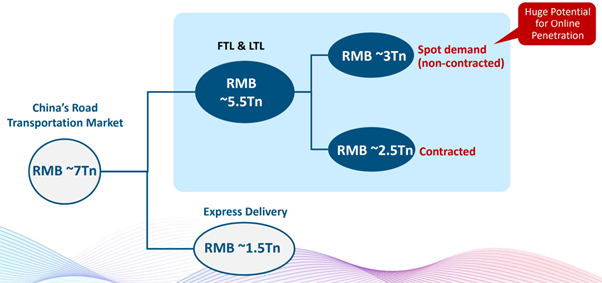
China's logistics market structure
As you can see from the image above (blue area), the FTL and LTL segment contract and spot markets make up Full Truck Alliance's key end markets. While average volume growth in the FTL and LTL markets is estimated at 6%–7%, the company's revenue is growing much faster. For example, Full Truck Alliance's revenues grew 25.3% in 2023.
The main reason for this is the low level of digitalization in the Chinese logistics market. To date, a significant amount of transport is organized by freight brokers without the use of modern technology. When a company needs to ship a consignment, it turns to carriers it already knows or to intermediaries (brokers) who search for carriers. In both cases, the customer has to pay a higher price than with Full Truck Alliance because brokers charge a commission and different carriers often do not compete for the customer. Full Truck Alliance's digital solutions therefore have a number of advantages over traditional logistics solutions.
- Diverse choice. FTA platform features carriers with vehicles of all sizes, which perform daily runs on 40,000 routes within China. The platform is constantly increasing the number of active monthly carrier users, which currently stands at 3.2 million. Thanks to a wide range of options, customers are guaranteed to receive a market price for the transportation of their cargo.
- Quickness. Instead of lengthy negotiations in the case of traditional solutions, the FTA platform allows users to resolve commercial issues in a matter of minutes. The average time from placing an order to concluding a contract with a carrier is 14 minutes.
- Quality service. Full Truck Alliance acts as an independent mediator in disputes arising between shippers and carriers, maintaining a balance of interests, which significantly reduces the likelihood of potential litigation.
- Availability of value-added products. In addition to the above basic functions, the FTA platform provides cargo insurance, customer and shipper ratings, additional party support options for a fee in the form of subscriptions, as well as other services depending on customer needs.
Thus, despite the large size of China's logistics market, most of it is currently offline. Full Truck Alliance's digital platform offers huge advantages over traditional logistics solutions and is a beneficiary of the digitalisation of the Chinese transport market. During the Q2 2024 investor conference call, Full Truck Alliance's management expressed confidence that the company will continue to replace offline players through its value proposition.
Reason 2. Good time to enter
Despite Full Truck Alliance's positive business prospects linked to the digitalization of the Chinese logistics market, the company's capitalization has been declining since the beginning of the summer. Full Truck Alliance's financial results played a certain role in this process, as the stock's decline accelerated after the release of the results. In total, the market value of the company's shares has fallen by 25% since its peak at the end of May.
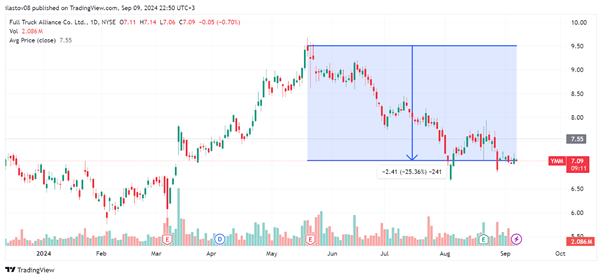
Correction in Full Truck Alliance stock
According to the company's management, the recent sharp decline in Full Truck Alliance's capitalization was due to investors' concerns that the company had reduced the growth rate of orders fulfilled through the platform. While this figure grew 29.7% YoY in Q1 2024, the growth rate fell to 22.0% at the end of Q2.

Dynamics of growth of completed orders
As noted by the company's management, the slowdown in growth was due to two reasons:
- reduced demand for road transportation due to macroeconomic problems;
- extreme adverse weather conditions in the Asia-Pacific region.
In particular, in May and June 2024, China experienced prolonged heavy rains in the eastern and southern parts of the country, leading to flooding in the south of the country. This was one of the main reasons that limited Full Truck Alliance's operating performance gains, as the speed of freight delivery and overall willingness of carriers to embark on trips declined. The chart above shows that the correction in the company's stock began in the second half of May, concurrent with the onset of the heavy rains.
Nevertheless, in our opinion, negative weather conditions are not a factor determining the fundamental value of Full Truck Alliance securities, as this is a one-time factor. In this regard, it is worth noting that, although Full Truck Alliance experienced a slowdown in the growth of completed orders, the company still:
- demonstrates a higher rate of increase in this indicator than the market average;
- is ramping up other important metrics, including those related to the company's new products.
Thus, at the end of Q2 2024, the number of active average monthly shippers placing orders on the FTA platform (Average Shipper MAUs) reached 2.7 million (+32.8% YoY), showing one of the highest increases in recent years and for the first time breaking out of the 1.9–2.2 million range that the company has seen since 2022.

Dynamics of Average Shipper MAUs
Full Truck Alliance has also significantly increased its financial performance, as detailed below. In particular, the company is constantly finding new points of growth, which stimulates an increase in its overall revenue. It is due to this model that Full Truck Alliance consistently performs stronger than its competitors.
One of these growth points was an online transaction service that began monetizing in 2020. This service provides the payment infrastructure within the company, and the majority of financial transactions between customers are now carried out through Full Truck Alliance solutions.
As a result, the company has been able to monitor the solvency of shippers and carriers, as well as introduce special conditions that must be met by participants in a transaction in order for it to take place. In addition, Full Truck Alliance gradually began to introduce commissions for certain transactions, which, according to the company, did not affect customer loyalty. While in 2020, only three cities in China were subject to commissions, by the end of 2023, the number of locations had grown to 204.
As a result, revenue from the transactional business showed the strongest growth for Q2 2024, totaling ¥0.95 billion vs. ¥0.58 billion a year earlier (+63.3% YoY).
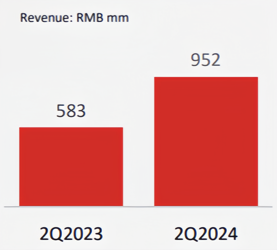
Transaction business revenue dynamics
In addition, Value-Added Services revenue, which previously accounted for only a small share of revenue, is having an increasingly significant impact on the company's overall revenue.
By related services, the company means:
- issuing loans to users of the platform;
- commission income from insurance companies, gas station owners, auto repair shops and other intermediaries for recruiting truck drivers to the Full Truck Alliance platform.
The company's commission revenue is naturally affected by the growing number of carriers using the company's services, which means that the network effect will scale as the business continues to expand. Value-Added Services revenue increased by 32.1% to 15.8% of the total for Q2 2024.
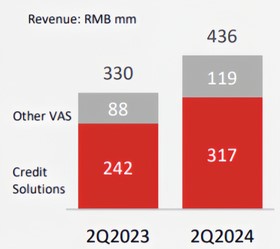
Dynamics of revenues from Value-Added Services category
Thus, despite the temporary difficulties associated with extreme weather conditions and reduced demand for freight transport, Full Truck Alliance retains growth drivers in both traditional and relatively new business segments. We believe that this, together with the digital transformation of the Chinese logistics market, will allow the company to continue to maintain high growth rates in its financial performance.
Reason 3. Share buyback program
In March 2024, Full Truck Alliance adopted a one-year, $300 million share repurchase program.
At the end of August 2024, Full Truck Alliance had repurchased $30.7 million worth of shares, leaving approximately $269.3 million, or 3.55% of the company's current market capitalisation, remaining under the programme.
Financial performance
Full Truck Alliance's financial results for the trailing 12 months (TTM) can be summarized as follows:
- Revenues totaled $1.36 billion, up 14.60% from 2023.
- Operating income increased from $140.49 million to $257.63 million. Operating margin rose from 11.82% to 18.92%.
- Net income was $365.02 million compared to $311.68 million at the end of last year.
Revenues increased due to higher demand for all types of services provided by the company, which also had a positive impact on the results for H1 2024. At the same time, it is worth noting that net profit exceeds operating profit. This is due to the fact that the company receives a large amount of interest income.
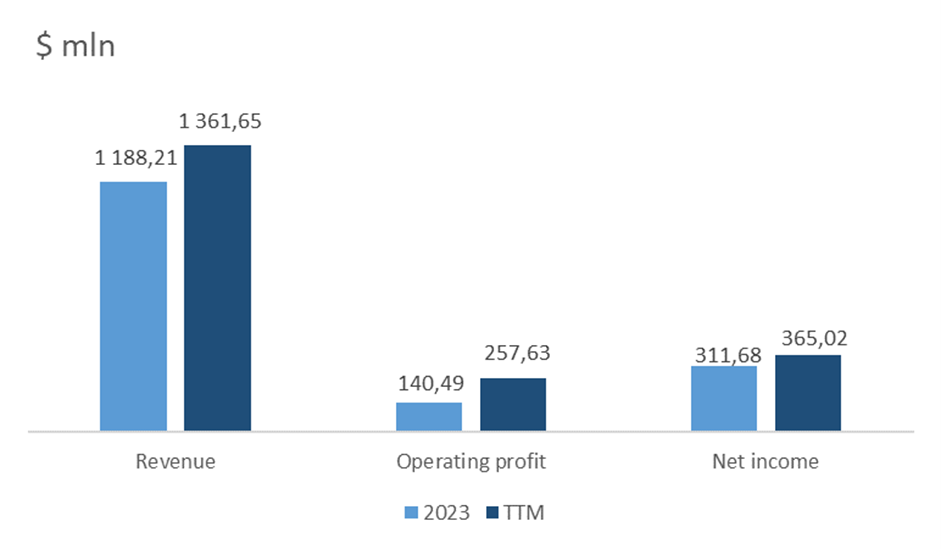
Dynamics of the company's financial indicators
Full Truck Alliance's results for H1 2024 are summarized below:
- Revenue increased 33.41% YoY, from $519.12 million to $692.56 million.
- Operating income grew to $120.75 million from $3.61 million.
- Net income was $193.24 million, compared with $139.90 million a year earlier.
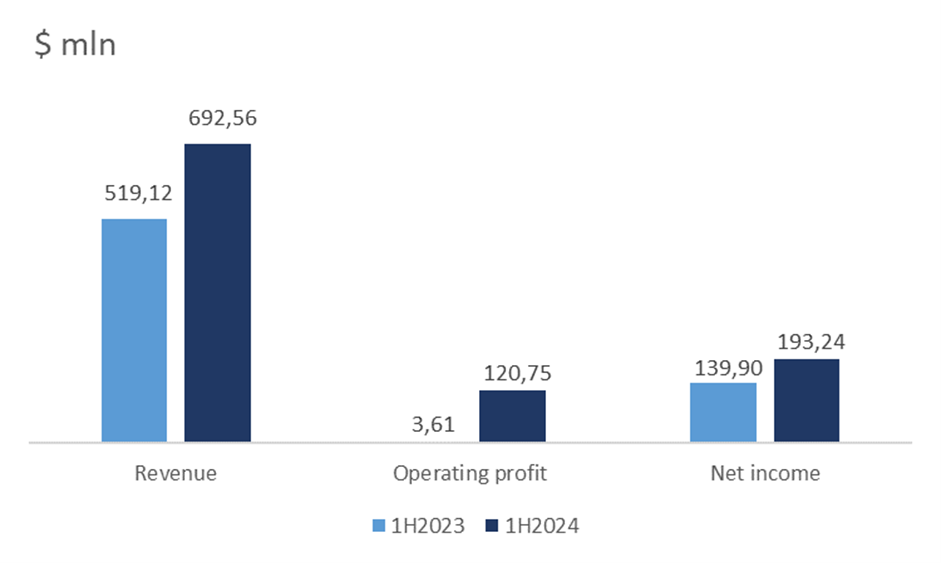
Dynamics of the company's financial results for H1 2024
- TTM operating cash flow declined slightly to $315.37 million versus $319.67 million in 2023.
- Free cash flow is almost identical to operating cash flow due to low capital expenditures.
Operating cash flow remained at approximately the same level.

Company cash flow
Full Truck Alliance has a healthy balance sheet:
- The debt portion of the balance sheet consists solely of operating leases and totaled $11.45 million.
- Cash equivalents and short-term investments account for $2.30 billion.
Full Truck Alliance has practically no debt, which speaks for the absolute financial stability of the company. It is also worth noting the high level of cash reserves, which allows the company to expand its market presence, launch new projects and participate in M&A transactions without the need for significant external financing.
Full Truck Alliance forecasts Q3 2024 revenue growth of 21.9%–24.6% YoY. This gives confidence in the share price growth potential.
Stock valuation
Full Truck Alliance trades at a premium to the industry average: EV/Sales — 3.75x, EV/EBITDA — 13.41x, P/E — 21.16x and Fwd P/E — 19.49x. The premium is explained by the high growth rate demonstrated by the company, as well as the uniqueness of its business: there are no players on the market that can really compete with FTA's digital platform.

Comparable estimate
The average price target from the top-5 investment banks is $11.9 per share. According to our consensus, the company is undervalued by industry average multiples: the stock’s fair market value is $10.2, which implies a potential upside of 41.7%.

Price targets of investment banks
Key risks
Possible slowdown in the Chinese trucking market. If the market does not show the expected growth rates, Full Truck Alliance may find it difficult to maintain double-digit revenue growth rates, which could have a negative impact on investor sentiment towards the company.
Continued adverse weather conditions. During the Q2 2024 earnings call with investors, management reported that heavy rains in China were still ongoing, which could again dampen the company’s performance in Q3 2024.
Emergence of new competitors. There are currently no players in the market that operate similar digital marketplaces for organizing freight transportation. However, in the future, large technology companies or other industry players in China may develop their own platforms and create competition for Full Truck Alliance, which could slow the company's business growth rate.